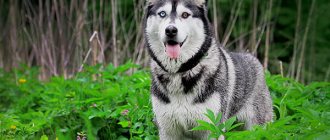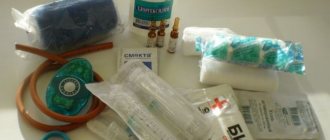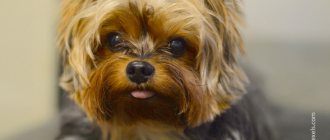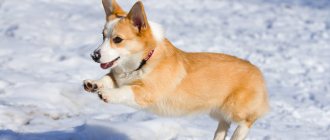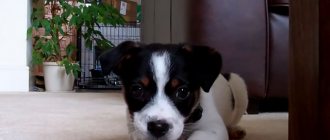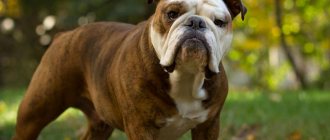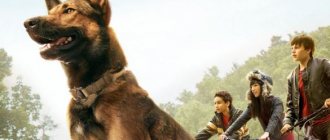Akita Inu can be described in one succinct word - “dignity”. The birthplace of the breed is Japan, so it is not surprising that they represent a national symbol and are considered a real “treasure of Japan.”
Dogs of this breed are very popular not only because of their unique appearance, but also because these animals have a very balanced character, while these pets are quite devoted to their owner, as well as members of the entire family. The story of the dog Hachiko, a member of the Akita Inu breed, is proof of his special devotion to humans.
History of the Akita Inu breed
According to information from ancient historical sources in Japan, the ancestor of modern representatives of the breed is the Matagi Inu (Matagi is an ethnic group of hunters, inu is “dog”).
The region of origin of the Akita Inu is considered to be Akita Prefecture on the island of Honshu. Matagi Inu and her ancestors served people as indispensable hunting assistants, allowing them to hunt even very large or agile animals: Japanese macaques, bears, wild boars. In the 12th-13th centuries, a new popular entertainment arose in Japan - dog fighting. It became a cruel selection for these dogs, leaving only the strongest, most evil and hardy. In the 19th century, a wave of industrialization swept across the country, many residents moved, and the number of crimes increased. Because of this, the Matagi Inu were retrained to guard property. At the same time, bullmastiffs, mastiffs, and Great Danes were brought from Europe to Japan, reviving the tradition of dog fighting. Increasingly, Akitas were crossed with these dogs to produce more aggressive and larger dogs.
This caused concern among Japanese dog breeders, because the breed began to lose its features, so in 1931 the Akita Inu was transferred to the status of a natural monument at the state level. Breeders are actively engaged in reviving the breed, selecting only the best representatives for breeding. The first official standard was introduced in 1934, but over time it had to be adjusted. Around the same time, the breed received its modern name, and in 1967 a thematic museum was opened.
The Akita Inu suffered serious damage during World War II - these dogs almost disappeared. They suffered from hunger, became victims of barely surviving people, their skins were used for clothing. At the end of the war, a government decree was issued to exterminate all dogs unsuitable for military purposes, since a real rabies epidemic had begun in Japan. For this reason, breeders hid some representatives of the breed in remote settlements, breeding them from the Matagi Inu. Hobbyists also bred hybrid generations of Akita and German Shepherd to adapt them for military service.
After the war, a new round of restoration of the Akita Inu breed began, the greatest contribution to which was made by Morie Sawataishi - it was thanks to him that these unique dogs have survived to this day. Purebred individuals had to be collected all over the country, but it paid off. The American military liked the charming and proud Akita, so the breed was brought to the United States.
Nutrition
Akita Inu can be fed at home with high quality food - fresh natural products or feed. Cooking takes time and requires careful calculations. You should create a dog’s menu so that pure protein makes up at least 30% of it. The diet includes meat and offal. Fish, vegetables, fermented milk - cottage cheese, sour cream, yogurt. It is not advisable to introduce milk - lactose intolerance is common in the breed.
Dry food for the breed must be of at least premium class, you need super-premium. Feed includes essential proteins and microelements. They are introduced into natural nutrition with the help of complexes of vitamins and minerals.
Features of the American Akita
The American branch of this breed appeared precisely after World War II, when US military personnel began to export puppies to their homeland. It is interesting that they were mainly interested in large mestizos, somewhat similar to bears, and not purebred dogs. This played into the hands of Japanese dog breeders, who did not want to share the laboriously recreated breed.
Selection experiments continued in the USA, where they managed to obtain more massive dogs with a menacing appearance - which is why we now have two varieties of the breed with significant differences. The Americans managed to gain recognition from the AKC (American Kennel Club, an organization that registers purebred dogs and new breeds) only after refusing to import new dogs from Japan. This led to a severe limitation of the gene pool, and therefore the development of the breed as such. The Japanese continued to work on colors, since they had a large variability of genes at their disposal. Today, the Akita Inu is considered a good companion, a devoted protector of the owner and his property.
Lifespan
The average life expectancy is 10-12 years, which is slightly less than that of other breeds of similar size. Females live slightly longer than males, but the difference is not very significant and amounts to a statistical 2 months. Moreover, it is typical for both Japanese and American Akitas, since they have the same roots.
Life expectancy was affected by the war, especially the bombing of Hiroshima and Nagasaki, since before it dogs lived 14-15 years. Don’t forget that large dogs usually live less than small ones, suffer from serious joint problems, and their hearts have to work harder.
Appearance and special features of the breed
The Japanese version is called Akita Inu - these are medium to large sized dogs with a dense, at the same time graceful physique. The head with small ears resembles a fox. Only a few color options are recognized. The fur must be short and there must be a white mask on the muzzle.
The version from the USA is called the large Japanese dog or American Akita. They are exceptionally large dogs with heavy bear-like heads. Almost any variant of suit is recognized, including black or with a dark mask.
general description
Akita Inu thrives in moderate to cold climates. Among the characteristic features:
- fairly large head;
- erect triangular ears;
- strong physique;
- tail curled into a donut.
An adult male has a height of 66-71 cm at the withers, weight from 45 to 59 kg. Females are 61-66 cm tall, weigh from 32 to 45 kg, while their body length is slightly longer than that of males. The Japanese version of the breed is slightly lighter and smaller. Eight-week-old puppies usually have the following parameters:
- large Japanese - weight 8.16-9.97 kg;
- Akita Inu – weight 7.25-9.07 kg.
The growth of dogs is slow; the animal’s development finally ends only by 3 years. Puppies gain weight quite actively (up to 7 kg per month); after reaching 35-49 kg, their development slows down greatly, but does not complete until the age of three. Don't worry if your pet doesn't quite fit into existing growth charts as these are very general guidelines. In general, the dynamics are as follows:
- 6 weeks – the puppies are large and very charming, little like adult dogs;
- 6 months – body proportions change, the dog becomes more toned, the puppy roundness disappears, characteristic features are more clearly defined;
- 1 year – bitches begin to heat, but they cannot be considered adults;
- 1-2 years – the growth process slows down greatly, but the transformation of the body continues, especially in the head area;
- 2 years – the dog stops growing in height, expands slightly in width, small changes will continue for another year.
Wool
The classic standard is a dense short coat (about 5 cm), which is slightly longer on the neck and tail. The coat is erect, made of coarse guard and needle-like hairs, the undercoat is very thick and downy. Akita Inu can only have this color:
- pure white;
- red with white fragments and mask (urajiro);
- brindle, also with urajiro;
- red with black tips of hairs (sesame).
The American Akita comes in any color. Long-haired dogs are often born - this is a consequence of a combination of recessive genes from the father and mother. They are the same in character, but do not fit into the standard, therefore they are considered a reject.
Ears
In puppies, the ears are drooping, while in adult dogs they are erect, facing forward and slightly to the sides. They do not accept this position immediately, and this is influenced by two factors:
- age - only as you grow older and strengthen the special muscles, the ears will begin to rise. Chewing and gnawing on toys can speed up this process;
- change of teeth - until permanent teeth appear in place of milk teeth, the ears will not rise completely.
It often happens that they fall back or only one ear is erect. This process takes from 10 weeks to 6 months, so there is no need to worry until six months - the position of the ears will level out.
Eyes
The eyes are brown (preferably as dark as possible), small, deep-set. They have a triangular "oriental" shape that is noticeable from birth. For dogs of light color, black “eyeliner” is allowed, which only emphasizes the special cut.
Tail
In purebred dogs it is fluffy, thick, and rolled into a tight ring. Babies have a straight tail that curls during the first 2 months of life. If the dog is sleeping or just relaxed, it may unwind slightly, but it never becomes straight. Visually and to the touch, this part of the body does not change even during the molting period. The fluffy “donut” tail seems to balance the pet’s large head.
Paws
The description of the paws differs little for different standards: straight, arched, with thick pads, similar to a cat's. Both varieties of Akita have tightly closed toes, which gives them the ability to swim well. In this case, not only the forelimbs are involved, but also the hind limbs. However, most dogs of this breed do not like to swim, entering the water only when absolutely necessary.
Wool
According to the American Akita breed standard, all types of colors are acceptable, including white, as well as a black mask on the face. Japanese dogs can be red with white color on the inner surface of the paws, chest and muzzle mask (the so-called “urajiro”), brindle with white urajiro, white. A black mask on the face is not acceptable.
There are two types of coats: short-haired and long-haired. Longhairs are not allowed to participate in the show and are considered a cull, but in character they are no different from shorthairs.
Long hair, also known as Moku, is a consequence of an autosomal recessive gene that only manifests itself if the father and mother are carriers.
Akita Inu character
It is difficult to briefly describe the character of this breed. Akitas are very versatile dogs. The American subspecies is distinguished by more serious habits, the Japanese are somewhat more playful and frivolous. At the same time, most representatives of the breed are not stupid sofa pets or overly gloomy dogs. There are several main character traits.
- Own independent thinking - this is often mistaken for stubbornness, but in fact it is enough to establish mutual understanding.
- The sense of hierarchy is very developed, so they try to establish a rank in relation to the owner’s other dogs. It is important to achieve recognition of the person as the leader within the first weeks and months of the dog’s life, otherwise he will dominate.
- Trainability – Akita Inu dogs quickly grasp new knowledge and skills, so they begin to get bored if they repeat the same thing for a long time. It is very important for them to understand why they perform certain tasks, so it is worth taking care to develop the right motivation.
- No fear of heights - it is worth blocking off the balcony and other dangerous places, because puppies are very brave and not too smart. Adult dogs jump high, caring little about where they land.
- Craving for space - they like to run a lot, frolic in nature, and visit new places. Physical activity is vital for them.
- Tenderness – mentally these dogs are very sensitive, they are easily offended.
- Loyalty to the owner - the Akita will not pester or interfere with everyday activities or recreation, but they are very loyal creatures. They love to quietly follow their owner everywhere.
- Patience – despite being dominant, a properly trained dog is incredibly patient. She will modestly wait for you from work or sit quietly by the bed, waiting for you to wake up.
- Attitude towards other people - Akita gets along well with older people. The attitude towards children depends on their behavior and family affiliation.
- Attitude towards dogs - if the other dog is smaller and lives in the same family, there will most likely be friendship. Relationships with representatives of the same species and the same sex, completely alien dogs, are difficult. Aggression (at least in the form of growling) is especially active if the second pet is of the same or larger size.
- Fear of small spaces – Akita Inu dogs do not like too cramped enclosed spaces. They try to get a good view and control of the space.
- Aggression – these dogs are very sensitive to the relationship between guest and owner. Welcome visitors need not worry. Such dogs do not like strangers, so they will closely watch the guest until they understand how appropriate his presence is in the house. Only proper training will help manage innate aggression.
- Security - they are good guards, but they do not immediately rush to bite. For example, they will simply try not to let a thief leave the house, waiting for the owner’s help.
- Barking dogs are fairly quiet dogs, but they are very sensitive to new people, animals and sounds, and are able to use their voice to issue a warning to someone who is invading their territory.
Socialization
Socialization should be done as early as possible, the most important time being from 3 weeks to 4 months. What is instilled in the puppy at this time will manifest itself as it grows. It is at this time that the Akita will find mutual understanding with the person or not. In addition, at this age the puppy learns about the world and must understand that this world is as big as its owner allows it to be.
It is important to introduce your puppy to as many places, people and events as possible. Everything that is laid down at this age will have a great impact on his entire life. He will absorb all impressions and draw conclusions from them. And when the Akita reaches 1 year, these ideas take root and can no longer be corrected.
This age is the foundation on which all further behavior of the dog is built. Although adult dogs can be retrained, changing attitudes is much more difficult than shaping them.
Don’t forget that before introducing your puppy to the world, you need to get all the necessary vaccinations and wait a while.
Care and maintenance
Despite its dislike for confined spaces, the Akita Inu is well suited both for living in a city apartment and for keeping in a private house. In any case, it is extremely important to provide long walks during which the dog can realize his energy. Start exploring the world around you after completing all vaccinations.
- Walk around the area and beyond, change routes every day.
- Visit both quiet and noisy places so that the dog gets used to as many situations as possible (park, forest, shops, beach, market, pet store, square). In the future, when she gets into a crowded place, she will not experience serious stress.
- During walks, keep your Akita on a leash, showing leader control.
- Although this breed does not like other dogs, teach them to behave calmly. When meeting another pet on a leash, let them get to know each other and sniff each other. If everything goes well, don't interfere. If aggression or growling occurs, separate the dogs.
- Teach your dog to travel in the car - start with trips of 5-10 minutes a day, gradually increasing this time to 35-45 minutes.
Paws
The description of the paws is the same in all standards, but differs in details.
Japanese Akita Club of America: Paws resemble those of a cat, thickly padded, arched, stable.
AKC: Cat-like, arched, straight.
Both types of Akita, Japanese and American, have paws with closed toes, which allows them to swim perfectly. They use both their front and hind legs when swimming, unlike other breeds that only use their front legs. At the same time, most of them do not like to swim and only enter the water if they are forced to do so.
Features of care
Akita Inu sheds heavily twice a year: from January to February and from May to June. During this period, the dog must be brushed every day or at least 3-4 times a week. The rest of the time, brushing 4 times a month is sufficient. Constant shedding is possible in a house with very warm and dry air. Another reason is illness or poor diet. There is no need to cut or trim your pet's coat. There are other care recommendations.
- Bathe your dog no more than 1-2 times a year so as not to wash off the special protective lubricant of the coat. These dogs are very clean themselves, they know how to lick themselves, and the rest of the dirt will be removed during brushing.
- Brush your pet's teeth 1-2 times a week. Use only a special product.
- Regularly examine your Akita's eyes and ears to notice inflammation, discharge or an unpleasant odor - all this indicates the need to urgently visit a veterinarian.
- Trim your nails every month if they don't wear down naturally.
Accustom your dog to any procedures while still a puppy. You may simply not be able to cope with an older dog or it may cause stress and loss of trust.
Theses
- They are aggressive towards other dogs, especially those of the same sex.
- These dogs are not for novice dog owners.
- Socialization and persistent, competent training are extremely important for these dogs. If they have not been treated or raised correctly, they often become aggressive.
- They shed a lot!
- They get along well in an apartment, but need walks and physical activity.
- They are excellent guards, attentive and reserved, but they need a firm hand.
Akita Inu Health and Diseases
This breed is in good health, provided that the puppy does not have any serious congenital defects. Sometimes they suffer from genetic diseases and are sensitive to certain medications. Among congenital and acquired/age-related ailments there are:
- entropy (inversion of the eyelid);
- hip dysplasia;
- bloating;
- glaucoma;
- cataract;
- pseudoparalytic myasthenia (weakness of all muscles of the body);
- von Willebrand disease (blood pathology);
- retinal atrophy.
Ears
One of the most common questions when an Akita's ears stand up? Adult dogs have erect ears, while puppies have downward ears.
Many owners worry about this, wondering at what age they will rise. Their excitement is understandable, since according to the breed standard, the ears should be small, erect and slightly tilted forward.
If you have a small puppy, then there is no need to worry. There are two points that are responsible for this process. The first is age. The ears will rise as the puppy gets older, as the muscles at the base of the ears need time to strengthen. Chewing speeds up this process as these muscles are connected to the jaw muscles. They become stronger during eating, and also when the puppy chews on toys or plays.
The second point is the loss of baby teeth. Don't expect your puppy to have erect ears until the teeth are completely replaced.
It often happens that they rise, fall, or one ear is erect and the other is not. There is no reason to worry, everything will even out over time. This process usually begins at 10-14 weeks of age and ends before six months of age.
How to choose a puppy
You can buy purebred puppies only from large, reliable breeders. The main signs of a healthy Akita Inu baby:
- active and cheerful;
- puppy of average fatness;
- beautiful shiny coat;
- runs confidently, stands firmly on its paws;
- not aggressive, not afraid of loud sounds.
Pay attention to the color and shape of the Akita Inu's eyes - if they are round and light, this is not a purebred pet. Features of the shape of the eyes are necessarily congenital, and the color changes with age only to a lighter color. The bite must be correct, the pigmentation of the nose and mouth must be uniform. If you buy a puppy older than six months, and its tail has not yet curled, this is a bad sign. If you plan to participate in competitions and exhibitions, then it is better to choose a baby with an experienced dog handler. When purchasing an ordinary pet, it is enough to use the criteria outlined above.
Attitude towards children
It largely depends on the character, behavior of the children and the age at which the Akita first encountered them. Puppies that grow up with children usually get along great with them.
Problems may arise if the dog is an adult and protects “its children.” They may interpret loud screams, running, fighting, and active games as an attack and will rush to defense. It is important not to leave such a dog unattended and to actively engage in socialization in order to accustom it to the activity and noise of children.
Main causes of premature death
By nature, representatives of Akita Inu are awarded with excellent health . Diseases characteristic of this breed are not fatal. However, there are incurable diseases that can cause premature death. Tuberculosis, rabies, Auska's disease (false rabies) - there is no cure for these diseases.
A number of diseases can be cured with timely consultation with a veterinarian and correct diagnosis. Such diseases are leptospirosis and plague. Accidents can also lead to the death of an animal.
Important!
The owner's attention to the pet, training, education - all this will help to avoid troubles on the street and at home.
Photo
Akita Inus are not popular in Russia and you don’t see them every day. Therefore, those who want to admire these amazing animals are invited to this section, where their photos are presented. Wise eyes, good nature – that’s what you’ll notice first. Akita Inu puppies are even more endearing: they are fluffy, soft lumps, similar to lumps, and different in color from adult animals. Place next to a photo of an Akita Inu as a child and as an adult - and the changes are amazing. Instead of a black or gray mask, you will find a white mask on an adult Akita.
Even in the photo, the Akita leaves no one indifferent. The dog combines intelligence, wisdom, loyalty, beauty, character and independence. And all this is surprisingly conveyed in the expression of the eyes and muzzle. Watch and enjoy!
Two words about the legendary Hachiko
The story of the dog Hachiko shook all of Japan back in 1932. In honor of the heartbreaking story, a real monument was erected to the dog at the scene of the events.
A dog named Hachiko met his owner every day from work near the train station. But one day the man did not return from work - the owner of his faithful Akita died at work. Over the next 9 years, Hachiko came to the meeting place with the owner every day at the same time and waited for him.
The story gained such resonance that after the death of the dog, mourning was declared in Japan. Today, the Hachiko monument is a symbol of selfless love and fidelity. This story became known to the whole world after the release of the film “Hachiko: The Most Faithful Friend” in 2009.
Kinds
Dog breeders used large dogs for different purposes and distinguished three types:
- Hunting ones are the most ancient. Used for hunting large game.
- Guard Akita Inu were used to protect homes and possessions.
- Fighting representatives were distinguished by their power and strength and were popular in battles. Since 1908, fighting was declared prohibited and the breeding of such dogs stopped.
Physical data
Representatives of the breed grow slowly. The Akita Inu reaches the size of an adult dog at about three years of age.
The standard provides for the following growth parameters:
- 64-70 cm – for males;
- 58-64 cm – for females.
The weight of the female is 32-45 kg, the male – 40-45 kg.
Dogs weigh about 30 kg per year, when body weight reaches 35 kg, growth slows down somewhat. At this time, other changes continue: the chest expands, the stomach tightens, and posture is formed.
